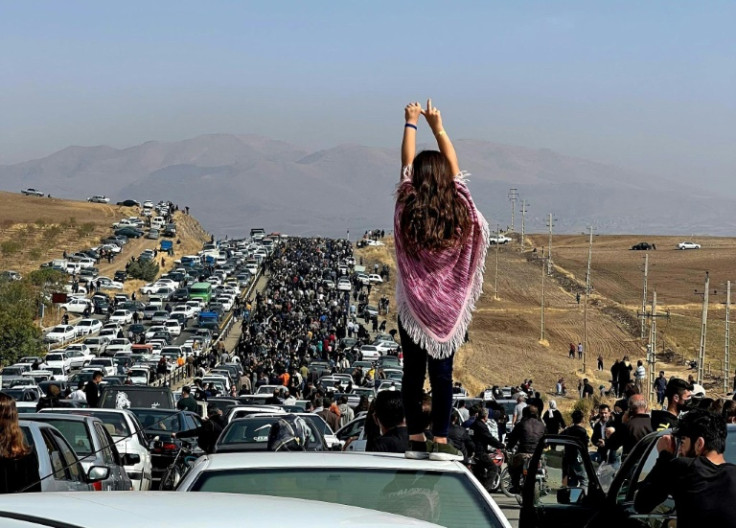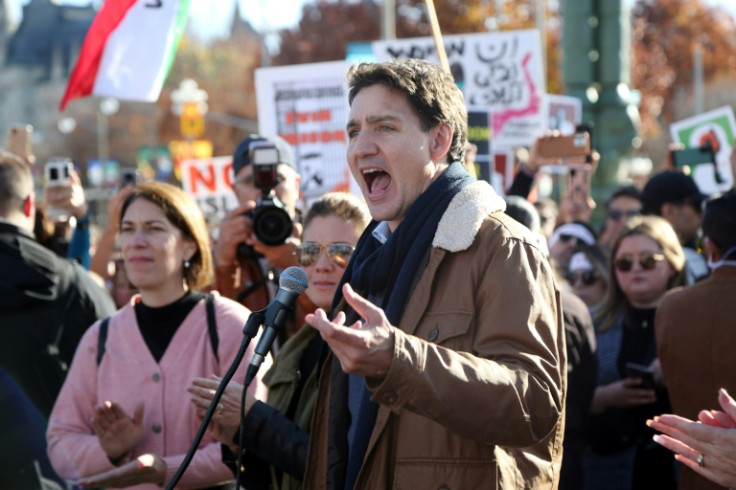Iran Protesters Rally Again Despite Guards Order To Stand Down

Iranian protesters rallied again Sunday, defying an order by the powerful Revolutionary Guards to stop the demonstrations -- now in their seventh week -- sparked by the death of Mahsa Amini
Students gathered overnight and Sunday across Iran, even after Major General Hossein Salami, head of the Islamic Revolutionary Guard Corps, had warned demonstrators: "Do not come to the streets!"
Amini, 22, died in custody on September 16 after her arrest in Tehran for an alleged breach of Iran's strict dress rules for women, triggering a wave of unrest and a state response on the "riots" that Amnesty International calls a "brutal crackdown".
Security forces on Sunday fired gunshots and tear gas at a gathering of students in the flashpoint western city of Sanandaj, where videos showed billowing clouds of smoke amid chants of "freedom", the Norway-based Hengaw organisation reported.
It also posted a video with the sound of echoing gunfire, and of a 12-year-old girl wailing with her bloody arm peppered with metal pellets, in reports AFP could not independently verify.
Security forces have struggled to contain the protests, which started with women taking to the streets and burning their hijab headscarves and which have evolved into a broader campaign to end the Islamic republic founded in 1979.
Students had protested on Saturday at campuses in Tehran, Kerman in the country's south, and the western city of Kermanshah, among others, online videos showed.
"Each person getting killed is followed by a thousand people!" protesters shouted at the funeral of a demonstrator on Saturday in Arak, southwest of Tehran, footage published by the 1500tasvir social media channel showed, adding that the crowd was later dispersed with tear gas.
Demonstrations on Sunday were reported in multiple universities including the capital as well as in Mazandaran and Mashhad, where Oslo-based group Iran Human Rights (IHR) said crowds chanted "Death to the dictator".
IHR said Friday that at least 160 protesters, including more than two dozen children, had been killed since protests began.
At least another 93 people were killed during separate demonstrations that erupted on September 30 in the southeastern city of Zahedan over the reported rape of a teenage girl by a police commander, according to the rights group.
In Amini's hometown of Saqez, security forces in plain clothes broke up a protest at a vocational college, where officers "attacked the students and abducted a number of them", Hengaw said.
Hundreds have been detained, and on Sunday more than 300 Iranian journalists and photojournalists signed a statement condemning authorities for "arresting colleagues and stripping them of their civil rights after their detentions".
Reformist daily Sazandegi said Sunday that "more than 20 journalists are still in detention", while the Tehran journalists' association dismissed the "security approach" as "illegal" and "in conflict with press freedom".
Tehran has sought to portray the protest movement as a plot hatched by its arch-enemy the United States, charging that some journalists had received "training courses" with the aim of changing power in Tehran.
According to local media, a report by the security services referred to journalist Elaheh Mohammadi from the Sazandegi paper and photographer Niloufar Hamedi of the daily Shargh, who helped publicise Amini's case and who have been detained for weeks.
Both their outlets challenged the report, with Shargh editor Mehdi Rahmanian insisting that "our journalist and our newspaper... acted within the framework of the journalistic mission".
The protests in Iran have been mirrored by scores of rallies of support in cities worldwide.
On Saturday, Canadian Prime Minister Justin Trudeau marched with protesters in the capital Ottawa, telling Iranian activists that "we will stand with you".



© Copyright AFP 2024. All rights reserved.





















